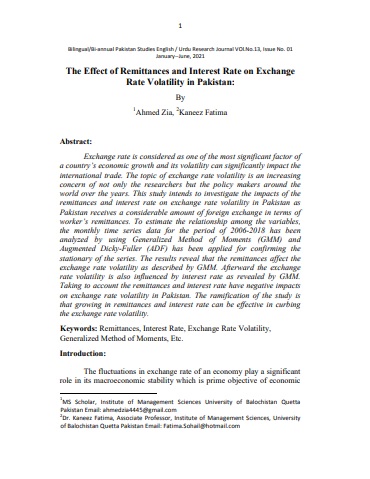The Effect of Remittances and Interest Rate on Exchange Rate Volatility in Pakistan
Keywords:
Remittances, Interest Rate, Exchange Rate Volatility, Generalized Method of Moments, Etc.Abstract
Exchange rate is considered as one of the most significant factor of
a country‟s economic growth and its volatility can significantly impact the
international trade. The topic of exchange rate volatility is an increasing
concern of not only the researchers but the policy makers around the
world over the years. This study intends to investigate the impacts of the
remittances and interest rate on exchange rate volatility in Pakistan as
Pakistan receives a considerable amount of foreign exchange in terms of
worker‟s remittances. To estimate the relationship among the variables,
the monthly time series data for the period of 2006-2018 has been
analyzed by using Generalized Method of Moments (GMM) and
Augmented Dicky-Fuller (ADF) has been applied for confirming the
stationary of the series. The results reveal that the remittances affect the
exchange rate volatility as described by GMM. Afterward the exchange
rate volatility is also influenced by interest rate as revealed by GMM.
Taking to account the remittances and interest rate have negative impacts
on exchange rate volatility in Pakistan. The ramification of the study is
that growing in remittances and interest rate can be effective in curbing
the exchange rate volatility.
References
Acosta, P. A., Lartey, E. K., & Mandelman, F. S. (2009). Remittances and
the Dutch disease. Journal of international economics, 79(1), 102-
Akbar Zaidi, S. (2015). Issues in Pakistan's economy: A political economy
perspective. OUP Catalogue.
Alagidede, P., & Ibrahim, M. (2017). On the causes and effects of
exchange rate volatility on economic growth: Evidence from
Ghana. Journal of African Business, 18(2), 169-193.
Ali, T. M., Mahmood, M. T., & Bashir, T. (2015). Impact of interest rate,
inflation and money supply on exchange rate volatility in Pakistan.
World Applied Sciences Journal, 33(4), 620-630.
Amuedo-Dorantes, C., & Pozo, S. (2004). Workers' remittances and the
real exchange rate: a paradox of gifts. World development, 32(8),
-1417.
Andrieș, A. M., Căpraru, B., Ihnatov, I., & Tiwari, A. K. (2017). The
relationship between exchange rates and interest rates in a small
open emerging economy: The case of Romania. Economic
Modelling, 67, 261-274.
Arellano, M., & Bover, O. (1995). Another look at the instrumental
variable estimation of error-components models. Journal of
econometrics, 68(1), 29-51.
Asari, F. F. A. H., Baharuddin, N. S., Jusoh, N., Mohamad, Z.,
Shamsudin, N., &
Benita, G., & Lauterbach, B. (2007). Policy factors and exchange rate
volatility. International research journal of finance and
economics, 7(8), 1-17.
Bussolo, M., & Medvedev, D. (2007). Do remittances have a flip side? A
general equilibrium analysis of remittances, labor supply
responses, and policy options for Jamaica. The World Bank.
Carrera, J., & Vuletin, G. (2002). The effects of exchange rate regimes on
real exchange rate volatility. A dynamic panel data approach.
University of La Plata and University of Maryland.
Demirag, I. S., Goddard, (1994). Financial Management for International
Business,
Demirag, I., & Goddard, S. (1994). Financial management for
international business. McGraw-Hill Book Company Europe.
Berkshire.
Frenkel, J. A., & Johnson, H. G. (Eds.). (2013). The Economics of
Exchange Rates (Collected Works of Harry Johnson): Selected
Studies. Routledge.
Gadanecz, B., & Mehrotra, A. N. (2013). The exchange rate, real economy
and financial markets. BIS paper, (73b).
Hunter, J. S. (1986). The exponentially weighted moving average. Journal
of quality technology, 18(4), 203-210.
Jusoff, K. (2011). A vector error correction model (VECM) approach in
explaining the relationship between interest rate and inflation
towards exchange rate volatility in Malaysia. World Applied
Sciences Journal, 12(3), 49-56.
Khurshid, A., Kedong, Y., Calin, A. C., & Khan, K. (2017). The Effects of
Workers'
Lee, H., & Kim, H. H. (2011). The Determinants of Korea's Terms of
Trade: The Real-Side Approach. Journal of East Asian Economic
Integration, 15(4).
Madura, J. (2020). International financial management. Cengage
Learning.
Makhlouf, F., & Mughal, M. Y. (2013). Remittances, Dutch disease, and
competitiveness: a Bayesian analysis. Journal of Economic
Development, 38(2), 67-97.
McGraw-Hill Book Company Europa, Berkshire.
Moosa, I. A., & Bollen, B. (2002). A benchmark for measuring bias in
estimated daily value at risk. International Review of Financial
Analysis, 11(1), 85-100.
Morgan, J. P. (1996). Reuters (1996) RiskMetrics-Technical Document.
JP Morgan.
Mundell, R. A. (1961). A theory of optimum currency areas. The
American economic review, 51(4), 657-665.
Okoth, M. N. (2013). The effect of interest rate and inflation rate on
exchange rates in Kenya (Doctoral dissertation, University of
Nairobi).
Pagan, A., & Ullah, A. (1988). The econometric analysis of models with
risk terms. Journal of applied Econometrics, 3(2), 87-105.
Reaz, M., Mahat, F., Dahir, A. M., Sahabuddin, M., Mahi, A., & Masnun,
A. S. M. (2017). Exchange rate volatility and financial
performance of agriculture firms in Malaysia: An empirical
analysis using GARCH, wavelet and system GMM. Business and
Economic Horizons (BEH), 13(1232-2017-2430), 409-427.
Remittances on Exchange Rate Volatility and Exports Dynamics-New
Evidence from Pakistan. Romanian Economic Journal, 20(63).
Schnabl, G. (2009). Exchange rate volatility and growth in emerging
Europe and East Asia. Open Economies Review, 20(4), 565-587.
Siregar, R., & Rajan, R. S. (2004). Impact of exchange rate volatility on
Indonesia's trade performance in the 1990s. Journal of the
Japanese and International Economies, 18(2), 218-240.
Sundqvist, E. (2002). An empirical investigation of the International
Fisher Effect.



